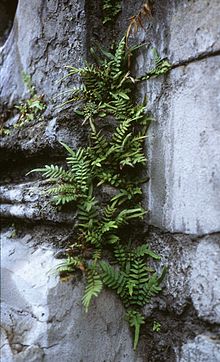Pteris vittata
| Pteris vittata | |
|---|---|
 | |
| Scientific classification | |
| Kingdom: | Plantae |
| Division: | Pteridophyta |
| Class: | Pteridopsida |
| Order: | Pteridales |
| Family: | Pteridaceae |
| Genus: | Pteris |
| Species: | P. vittata |
| Binomial name | |
| Pteris vittata L. | |
| Synonyms | |
Pteris vittata, commonly known variously as the Chinese brake, Chinese ladder brake, or simply ladder brake, is a species of fern in the genus Pteris. It is indigenous to Asia, tropical Africa and Australia. The type specimen was collected in China by Pehr Osbeck.
Habitat and distribution
Pteris vittata is often associated with limestone habitats. It may be seen growing on concrete structures and cracks, in buildings in the central business district and suburbs of Sydney, Australia.
Pteris vittata is native and wide spread in the paleotropics: found from the east, to the south tropical, and southern Africa (in Angola; Kenya; Lesotho; Malawi; Mozambique; Namibia; Tanzania (including the Zanzibar Archipelago); Cape Province, Free State, KwaZulu-Natal, and Transvaal in South Africa; Swaziland; Uganda; Zambia; and Zimbabwe); temperate and tropical Asia (in the provinces of Anhui, Gansu, Guangdong, Guangxi, Guizhou, Hubei, Jiangxi, Sichuan, Xizang, and Yunnan in China; the prefectures of Honshu, Kyushu, Shikoku, and the Ryukyu Islands of Japan; and Thailand); and Australia, in the states of New South Wales, Queensland, Victoria, and Western Australia.
It is an introduced species in California, Texas, and the Southeastern United States.
Uses
Although it grows readily in the wild, Pteris vittata is sometimes cultivated. It is grown in gardens for its attractive appearance, or used in pollution control schemes: it is known to be a hyperaccumulator plant of arsenic used in phytoremediation.
Suggested reading
References
External links
Retrieved from : http://en.wikipedia.org/w/index.php?title=Pteris_vittata&oldid=463243074